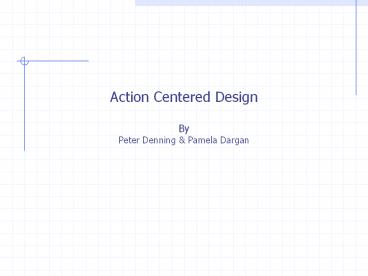Action Centered Design - PowerPoint PPT Presentation
Title:
Action Centered Design
Description:
US Govt. Accounting Office Review : Dept of Defense. Action ... for contact between them until delivery. Human Centered Design ... The maps would provide ways ... – PowerPoint PPT presentation
Number of Views:33
Avg rating:3.0/5.0
Title: Action Centered Design
1
Action Centered Design By Peter Denning Pamela
Dargan
2
- Peter Denning
- - Several prominent teaching and research posts.
- - President of the ACM
- - Spearheaded National Computing Curriculum
Taskforce (1989) - Denning Report
- Presently, Chairman of the Computer Science
Department at the Naval - Postgraduate School in Monterey, California
- Publications
- Working Sets and Virtual Memory
- Great Principles of Computing
- Professions and Futures
- Software Engineering, Architecture, and Quality
- Workflow and Commerce
3
Pamela Dargan - MITRE Corporation, -
Experienced Software designer belonging to MITRE
4
Problem Statement
How successful software designers had managed to
create software that users found usable and well
suited to their needs
5
Interesting Statistics
50 25 2
Fund Allocation
In Use
Never delivered
Delivered but not used
Software
US Govt. Accounting Office Review Dept of
Defense
6
Action Centered Design
A broader interpretation of design that is based
on observing the repetitive actions of people in
a domain and connecting those action-processes to
supportive software technologies
7
Approaches to Software Design
- Primary Meaning of Design To make or
conceive a plan - There are two principal approaches to it
- Product Centered Design (Software Engineering)
- Dated to 1960
- Based on the traditions of engineering, where
design is seen as a formal - process of defining specifications and
deriving a system from them. - Human Centered Design
- Dated to 1980
- Designers immerse themselves in the everyday
routines and concerns of the - customers
8
Product Centered Design (Software Engineering)
- The engineering design process operates on 3
assumptions - 1. The result of the design is a product
(artifact, machine, or system). - 2. The product is derived from specifications
given by the customer in principle, with - enough knowledge and computing power, this
derivation could be mechanized. - Once the customer and designer have agreed on
the specifications, there is little need - for contact between them until delivery.
9
Human Centered Design
Based on understanding the domain of work in
which the people are engaged, how they interact
Computers, and programming computers to do
exactly the same. The engineering design
process operates on 3 assumptions 1. The
result of the design is a satisfied customer. 2.
The process of design is a collaboration between
designers and customers it evolves and
adapts to their changing concerns, and it
produces a specification as an important
byproduct. 3. The customer and designer are in
constant communication during the entire process.
10
Donald Norman Product-Centered design
Focus on the machine and its efficiency,
expecting humans to adapt. Human centered
design Leaves to humans the actions that
humans do well such as understanding,
empathizing, perceiving etc. and leaves to
machines
what humans do not do well, such as performing
repetitive
actions without error, searching large data
sets, accurate calculations.
11
Action-Centered Design
Software designers must be trained to be
skilled observers of the domain of action in
which a particular community of people engage,
so that the designers can produce software that
the designers can produce software that assists
people in performing those actions more
effectively
12
Pattern Mapping as a basis for a Discipline of
Design
The maps would provide ways 1. To convey the
patterns of action of the domain in which the
software will be used, in terms of its
basic distinctions, repetitive processes,
standards of assessment, strategies, tools,
breakdowns, and driving concerns 2. To connect
the linguistic structure of the domain to the
software structures that will support the
patterns, and to guide software engineers in
implementing those structures 3. To provide a
basis for measuring the effectiveness of the
implemented system in practice
13
The basic patterns that these maps should cover
are A set of linguistic distinctions (verbs,
nouns, jargon, etc) A set of speech acts by
which domain participants declare and report
states of affairs. A set of standard practices
(recurrent actions, organizational processes,
roles, standards of assessment) in which
members of the domain engage. A set of
ready-to-hand tools and equipment that people use
to perform Actions . A set of breakdowns,
which are interruptions of standard practices and
progress caused by tools breaking, people
failing to complete agreements, external
circumstances, etc. A set of ongoing concerns
of the people in the domain -- common missions,
interests, and fears.
14
Summary
- Building this framework in which software
will be used, - Representing it as a pattern language in a
standard notation - Coordinating the work of builders
- is the central activity of a
software architect. - Practice of these skills is Action-Centered
Design































